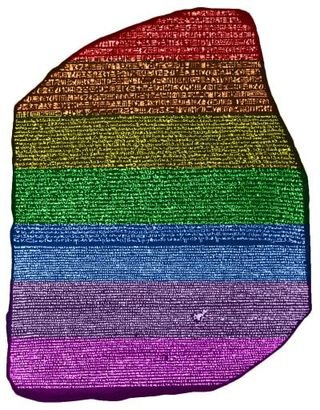Genetics
The Tetrachromacy Rosetta Stone
A new functionality test for tetrachromacy finds promising results.
Posted February 12, 2020 Reviewed by Devon Frye
"It was a Rosetta Stone moment; I felt like we had broken the code."
The recent correspondence from Kristopher Jake Patten, Ph.D., an affable and brilliant scientist studying the senses at Arizona State University, was epic. I realized I may be witnessing scientific history.

Late last year, Dr. Patten employed his new, breakthrough diagnostic pilot test to study talented interior designers Susan Hogan of Pittsburgh and Megan Arquette of Los Angeles and me. We all have positive DNA tests for tetrachromacy. He wanted to see if our rare color vision genes are functional. It appears they are in all three cases.
Tetrachromacy, or the presence of a fourth cone class in the retina, results in exponentially enhanced color vision. While it is rare, it is even rarer to find functionality testing for it. Research into this ability is very new and there needs to be much more funding for interested scientists. Even DNA testing is not yet widely available.
We were asked to take an online test that was something like a game or perceptual illusion, and each of us did so remotely from our homes. We answered separately without conferring with one another and anxiously awaited the results.
"Well, that worked better than I expected!" Dr. Patten emailed us the next day, reporting we each answered correctly.

While I can't reveal Dr. Patten's proprietary methods in these early stages, the test is fast, inexpensive, novel, and, in my view, ingenious. In a very straightforward way, you can either do it or you can't. It suggests a future where widespread testing for this trait could be available. Joining Dr. Patten in ongoing research is a team that includes Nobel Prize-winning physicist Frank Wilczek.
Why is functionality testing important? It matters because it is possible to have the genes (or genotype) for a trait and for them not to be "expressed" or flipped on. Having the phenotype—or active genes—means that people with this advantageous mutation can actually use the ability. (And by "people," I mean women. Tetrachromacy appears to require two X chromosomes.)

What are the evolutionary advantages of tetrachromacy? It is believed that a tetrachromat woman could spot early signs of fever in a baby by the slightest flushing of the skin. She could also spot changes in another person's skin tone signaling emotion. Dr. Patten says, in a modern and more urgent application, that tetrachromats could possibly spot those infected with coronavirus at the earliest stages.
"People with color blindness were used in World War II and Vietnam to spot enemy camouflage," he explained. "Embracing the differences of tetrachromacy could yield similar advances. A few recent studies have shown that people are better than chance at distinguishing between ill and well faces, possibly based on coloring. It might be the case that tetrachromats are even more sensitive to this coloration difference. As the world is currently dealing with the Wuhan coronavirus outbreak, an early detection method would be key to controlling the spread of the virus and saving lives. Tetrachromacy could hold the key to such technology."

Megan Arquette believes this is entirely possible, given her personal eyesight. "Years ago, before I worked as an interior designer, I worked on set as a makeup artist. It was crucial to get the skin tones perfect. Having the ability to see the parts of the sum of a color was invaluable. Not only was I able to see the subtle nuances in a person’s skin tone, but also the color break down of the makeup and how it worked with the temperature of the lighting and the surrounding throws of color that the set and clothing provided."
And she points out that nature has more colors than manufactured things made mostly by people with three cone classes. I agree.
"For me, organic things such as nature and even skin tone, have a much more varied color makeup than man-made items. The colors almost seem to be in constant motion when I stop and study the subject. This has been interesting as I’ve been able to identify that someone is not feeling so great before they tell me. I literally see greens and grays in the skin tone, like the ones you see in cartoons, when someone is under the weather."
Susan Hogan says she readily notices the yellow tones on the skin of people with liver disease and finds the flush of fever, particularly in children, "easily identified."
Indeed, I found very early pre-cancerous pink lesions on a loved one's face years ago, before this person or his primary care physician noticed, and well before I knew there was a name for my peculiar color vision. The man sought testing and is well today. Needless to say, the implications for medicine, and even the arts, are huge.
United States Army veteran Arthur Skip Maselli, a former government satellite engineer and vision expert, tells me it is not just about a wider range of color vision but that such people should have far better depth perception due to their ability to see more shading around objects. Therefore, there may be defense applications for imagery analysis.
It is significant that each of we three functional tetrachromats self-identified and sought testing after learning about the trait in the media. Why would we seek DNA testing in the first place if we didn't know something was afoot and think we had the experiences and behaviors of extra cones for color? It is personally validating to have this supportive evidence now, but we all felt as if we knew it all along.
Susan Hogan has always reveled in the tones all around her, for example. She says her favorite colors to see are in humanity and nature. "Being a people person, I love looking into the eyes of people I see on the streets. The beautiful array of eye color, hair color, clothing—each unique; each lovely. Then I look around me and see the beautiful shades of blues and greens, yellows, reds, and pinks in nature. What a gift... I'm truly grateful."
What are the telltale signs of tetrachromacy? In our cases, we all have enormous affinity for color. All have a rich vocabulary for hues and are persnickety about the names for them. And we all have frequent, polite disagreements with others about the exact shades of things.
While our trait is obvious to us and the people closest to us, we all wanted science behind it. The internet is rife with amateur "tests" for it, signaling great interest on the part of the public—much like when the "What Color is the Dress?" debate caught fire. While some of these tests may be suggestive of tetrachromacy, they are far from conclusive. Having the imprimatur of positive DNA and functionality testing by a major laboratory adds legitimacy.
"When I looked at the results of our first pilot study, I was astonished!" Dr. Patten wrote to me via email. "I had spent the previous few days poring over previous research, applying old solutions to new problems, trying to fit square pegs to round holes, and all the other cliches." He says he kept coming back to one idea, but didn't really think it would yield much of a result.
"I asked Maureen, Megan, and Susan to play an online game that used some of the same principles and their data came back drastically different from the trichromats I had also tested. It was a Rosetta Stone moment; I felt like we had broken the code. We've developed a protocol to investigate answers to the game in more detail and then we'll know for sure. "
Personally, Dr. Patten is now a hero to the three of us—possessing the "skeleton key" to our perplexing, unique sensoria. I wanted to know what interested him about the gift in the first place.
"One of the things that first drew me to science was the similarity between crafting and analyzing a good experiment and solving a puzzle," he said. "When I first learned about tetrachromacy, it struck me as a particularly tough puzzle. We live in a trichromatic world where all man-made objects are printed in or displayed in combinations of three colors, so artificial, well-controlled stimuli are of no use. Objects with a peak reflectance in the range corresponding to the fourth cone of tetrachromats certainly exist in nature, but searching for the perfect mineral or plant pigment would be a fool's errand."
Dr. Patten notes that it is a bit like a heist movie where the thieves can't use brute force or work out an inside job. "Our two easiest avenues of unraveling the mysteries of tetrachromacy are cut off. But also like a heist movie, that's when the story gets interesting; it means we have to piece together unorthodox solutions by drawing from disparate areas of vision and color processing."
Interestingly, many women who have tetrachromacy also have color-blind men in their families. And extrapolating from men’s color blindness statistics, researchers now believe as many as 12 percent of women could have the genes. Far fewer are expected to be functional. Our studies continue; next, we will be asked to sort subtly colored cards that will be sent in the mail.
Megan Arquette and I are also each poly-synesthetes and wonder if constantly perceiving color through those traits "primed" us somehow for functional tetrachromacy, as lifelong exposure to a wide spectrum is considered one of the factors. It is too early to say.
If you're interested in learning more, here is an interview with Megan on NPR.




